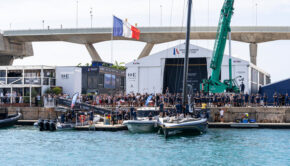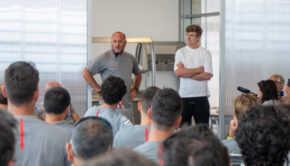America’s Cup, Sailing, and Social Responsibility
Published on June 10th, 2020
by Lynn Fitzpatrick
Just as the world began to come out of pandemic-imposed isolation and taking stock of our lives, our environment, and our connectedness, George Floyd’s murder became the flashpoint for systemic racism in America.
Worldwide, people are showing their solidarity in the largest civil rights protest in history. The strife is a symptom. The remedy is change.
As individuals, community sailing centers, sailing clubs, yacht clubs, and camps develop creative ways to sail safely and adhere to social distancing rules vis-à-vis COVID-19, it’s also time to proactively consider how to bridge the social distancing that the global sailing community has maintained vis-à-vis race.
World Sailing’s Constitution begins with the organization’s objects and aims, “to promote the sport of sailing in all its branches regardless of color, gender, physical ability, sexual orientation, language, political or other opinion, national or social origin; property, birth or other status.”
Whether your sailing facility is on private property or sits on ground-leased public land, and especially if your event and the infrastructure upon which it is held have benefitted from taxpayer funding, it is incumbent upon you to open your doors, give back to the community, and share the rich lessons of the sport.
That means having open houses and allowing open dialog, making sailing and S.T.E.M. courses more available, and structuring diversity and inclusion into events.
Captain Sarno, with South Africa’s 2007 America’s Cup entry, Shosholoza, gave the 32nd edition and the sport its version of the Jamaican bobsled team that was the sensation of the 1988 Winter Olympics and the inspiration for the Disney movie, Cool Runnings.
Not only did Shosho have spirit, pride, a raison d’etre, an educational program, and sponsors, it won the hearts and minds of the America’s Cup spectators globally.
However, in 2011, Charles Kithcart and I registered African Diaspora Maritime, the inclusive team featuring black sailors, for the 34th America’s Cup, and the organizers prevented it from participating.
Golden Gate Yacht Club, situated on public property, benefitted from public funding to host the event, and ultimately generated approximately 25% of the economic impact projected by the feasibility study used, and left the taxpayers in the red for over $11 million.
Then, as now, the organizers took the money based on inflated projections. Then, as now, one of the key drivers of the consultants’ economic impact study was the number of syndicates.
Kiwi taxpayers have shelled out over $200 million anticipating a low of six challengers for the 2021 America’s Cup, but at this point, just three “super teams” are positioning themselves with the New Zealand government to infiltrate the coronavirus-free island nation’s borders.
A fourth challenger, Stars + Stripes Team USA, an inclusive and authentic American team, was accepted by the hosts, paid its fees, and continues to cooperate with the event organizers, woo sponsors, and keep its eyes on the prize. While behind the others, delay AC36 by a year, and the likelihood of its participation skyrockets.
African Diaspora Maritime also applied for this America’s Cup, and once again it was rejected. Unlike Malta Altus and Dutch Sail, two other challengers that were accepted (but have since withdrawn), African Diaspora Maritime did not receive special dispensation from the organizers.
World Sailing, along with the Kiwi government and America’s Cup organizers, should examine the situation and reposition AC36 in 2022 to give New Zealanders the opportunity to capture economic benefit rather than socialize the Cup’s losses on citizens who are already reeling from the pandemic.
If the teams want in, give them an arrival deadline, contractually hold them to making their New Zealand bases their primary bases through 2022, host preliminary events in 2021 during the summer in the Southern Hemisphere, have each team host an event in its country of origin during 2021 (any one-design fleet will do), and revisit each of the teams that applied for the 36th America’s Cup.
Facilitate their ability to participate in full or as an exhibition team. While the “super teams” bellyache about the burn rate of maintaining a team for another year, let them analyze the financial offset of selling or leasing their first-generation boats, simulators and data, and design packages to the teams that will attract the most positive media attention to the sport, help heal global racism, generate economic impact, and set a positive example.
Not only will the superyachts and J-Class visit New Zealand for a new and improved AC36, sailors and non-sailors alike who want to see positive change, will tune into sailing’s pinnacle event. The sport will grow.
36th America’s Cup
In addition to Challenges from Italy, USA, and Great Britain that were accepted during the initial entry period (January 1 to June 30, 2018), eight additional Notices of Challenge were received by the late entry deadline on November 30, 2018. Of those eight submittals, entries from Malta, USA, and the Netherlands were also accepted. Here’s the list:
Defender:
• Emirates Team New Zealand (NZL)
Challengers:
• Luna Rossa (ITA) – Challenger of Record
• American Magic (USA)
• INEOS Team UK (GBR)
• Malta Altus Challenge (MLT) – WITHDRAW
• Stars + Stripes Team USA (USA)
• DutchSail (NED) – WITHDRAW
Of the three late entries, only Stars+Stripes USA remains committed, but they still must complete the entry fee payment process before they will be eligible to race. They have allegedly made their initial payment but as a late entry challenger under the Protocol, they also have a liability to pay a US$1million late entry fee due in installments by October 1, 2019. However, it is not yet confirmed if they have paid the fee, nor is there any knowledge of a boat being actively built or sailing team training.
Key America’s Cup dates:
✔ September 28, 2017: 36th America’s Cup Protocol released
✔ November 30, 2017: AC75 Class concepts released to key stakeholders
✔ January 1, 2018: Entries for Challengers open
✔ March 31, 2018: AC75 Class Rule published
✔ June 30, 2018: Entries for Challengers close
✔ August 31, 2018: Location of the America’s Cup Match and The PRADA Cup confirmed
✔ August 31, 2018: Specific race course area confirmed
✔ November 30, 2018: Late entries deadline
✔ March 31, 2019: Boat 1 can be launched (DELAYED)
✔ 2nd half of 2019: 2 x America’s Cup World Series events (CANCELLED)
✔ October 1, 2019: US$1million late entry fee deadline (NOT KNOWN)
✔ February 1, 2020: Boat 2 can be launched (DELAYED)
✔ April 23-26, 2020: First (1/3) America’s Cup World Series event in Cagliari, Sardinia (CANCELLED)
✔ June 4-7, 2020: Second (2/3) America’s Cup World Series event in Portsmouth, England (CANCELLED)
December 17-20, 2020: Third (3/3) America’s Cup World Series event in Auckland, New Zealand
January 15-February 22, 2021: The PRADA Cup Challenger Selection Series
March 6-15, 2021: The America’s Cup Match
AC75 launch dates:
September 6 – Emirates Team New Zealand (NZL), Boat 1
September 10 – American Magic (USA), Boat 1; actual launch date earlier but not released
October 2 – Luna Rossa (ITA), Boat 1
October 4 – INEOS Team UK (GBR), Boat 1
Details: www.americascup.com








 We’ll keep your information safe.
We’ll keep your information safe.